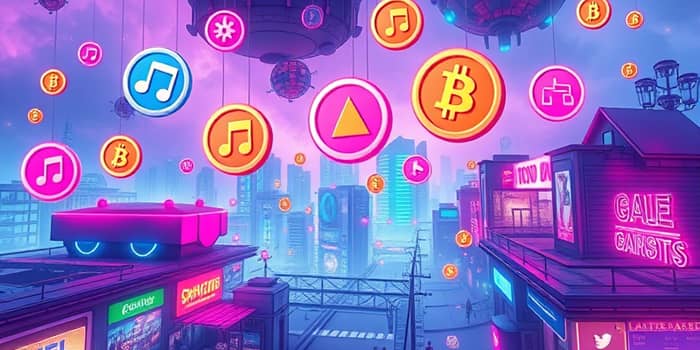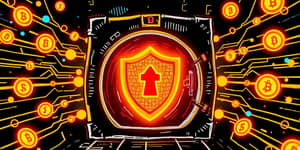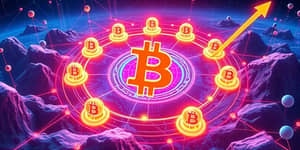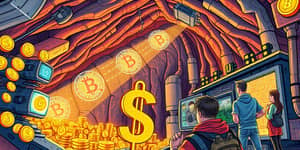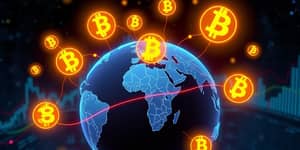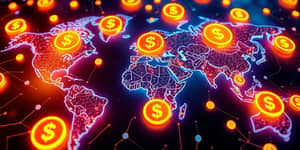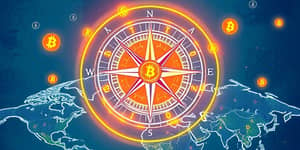NFTs have surged from niche experiments into a mainstream phenomenon. Far beyond mere pixels, they represent new possibilities in value exchange, creativity, and ownership. This article explores the technology, market dynamics, diverse applications, and future of these revolutionary tokens.
Definition and Technology Foundations
An NFT, or Non-Fungible Token, is a unique digital identifier recorded on a blockchain that certifies ownership and authenticity. The term non-fungible emphasizes that each token is not interchangeable and uniquely identifiable asset, unlike cryptocurrencies such as Bitcoin or Ethereum, which are fungible and have equal value per unit.
NFTs are minted, transferred, and stored on public blockchains, functioning as cryptographic assets that leverage ERC-721 and ERC-1155 token standards on networks like Ethereum and Solana. Embedded metadata tracks the creator, timestamp, and ownership history, forming a transparent ledger that underpins the token’s identity. This metadata can also reference off-chain assets, linking to artwork, videos, or even physical goods.
Minting an NFT involves deploying a smart contract that assigns a unique token ID and links it with asset metadata. Transaction fees, known as gas fees on Ethereum, compensate network validators and can fluctuate based on network demand. Secondary marketplaces automatically enforce royalty payouts, ensuring creators earn a percentage each time their work is resold, fostering a more equitable creative economy.
Market Size, Growth, and Key Statistics
The global NFT market has experienced exponential growth in recent years. Valued at approximately $43.08 billion in 2024, it soared to $61.01 billion in 2025 and is projected to reach an astonishing $247.41 billion by 2029, reflecting a compound annual growth rate (CAGR) of 41.9%. Other projections estimate the market could surpass $703.47 billion by 2034, driven by widespread adoption and innovation.
Quarterly and monthly sales metrics highlight this momentum. In Q1 2025 alone, NFT trading volume hit $8.2 billion, while July 2025 saw $574 million in sales, marking a 47.6% increase month-over-month, with an average sale value of $113.08. Daily active NFT wallets climbed to 410,000 throughout 2025, representing 9% year-over-year growth, and more than 85 million tokens were minted in the first half of 2025. Remarkably, 52% of trades in 2025 came from the secondary market, signaling mature investor engagement and trading activity.
Despite market corrections and evolving investor sentiment, institutional interest continues to rise. Major auction houses now feature NFT sales, and public companies are allocating budget to digital collectibles and tokenized perks. Nonprofit organizations experiment with NFT-based fundraising, leveraging scarcity and provenance to engage donors in novel ways.
Diverse Use Cases Beyond Digital Art
From digital galleries to virtual stadiums, NFTs empower creators and audiences alike. Nike’s Cryptokicks project illustrates how footwear companies can link physical sneakers to digital twins, enabling resales and provenance tracking. Meanwhile, communities like Bored Ape Yacht Club leverage tokens as membership badges, granting exclusive events, merchandise, and collaborations.
- Collectibles: Comic books, sports memorabilia, and limited-edition trading cards that carry certificates of authenticity, ownership, and provenance.
- Gaming: In-game assets such as skins, weapons, and virtual land that can be traded or monetized across platforms.
- Music and Video: Tokenized tracks and films that enable artists to earn royalties automatically through smart contracts.
- Physical Asset Tokenization: Tying luxury watches, real estate deeds, and high-value goods to NFTs for seamless transfer of title.
- Financial Applications: Cross-border remittances, microloans, and cutting-edge decentralized finance applications in emerging markets.
In gaming, platforms such as Axie Infinity have enabled players in developing countries to earn substantial income through play-to-earn models. Artists in music have released limited-edition albums as NFTs, unlocking direct-to-fan sales and automated royalty distribution without intermediaries. Universities are exploring degree certificates on blockchain, reducing fraud and simplifying credential verification.
Geographic Distribution of Investments
NFT adoption varies significantly by region, reflecting cultural, regulatory, and technological factors. Key markets include:
- United States: Leading with 41% of global transaction volume in 2025.
- China: Capturing 16% share, despite regulatory ambiguity.
- South Korea: Driving 8% through gaming and K-pop initiatives.
- Germany and France: Combined 7% focusing on art and collectibles.
- UAE, Brazil, Argentina: Emerging hubs with growing market segments.
- Africa: 1.8%, led by Nigeria, Kenya, and South Africa, leveraging NFTs for digital empowerment.
Additionally, 12% of NFT projects in 2025 span multiple regions, displaying the global and collaborative nature of the ecosystem.
Singapore has emerged as a blockchain powerhouse, hosting over 140 NFT and Web3 startups in 2025. This dynamic ecosystem fosters cross-border collaborations, hackathons, and academic partnerships, positioning the city-state as a model for regulatory balance and technological advancement.
Industry Impact and Emerging Trends
NFTs have ushered in a new paradigm of digital ownership, fueling unprecedented demand for virtual assets and experiences. Younger generations, especially Gen Z, view NFTs as not just assets but as extensions of identity and community. Marketplaces such as OpenSea and Rarible, powered predominantly by Ethereum (accounting for approximately 62% of transactions), facilitate this exchange and catalyze innovation.
Smart contracts automate the execution of royalties and transfers, ensuring creators receive residuals on secondary sales. Meanwhile, brands and institutions are experimenting with blockchain-based memberships, token-gated content, and immersive metaverse collaborations. These initiatives underscore a shift from speculative trading to utility-driven and community-focused NFT applications.
Brands across industries are leveraging NFTs for loyalty programs, exclusive access, and immersive advertising. Fashion labels distribute tokenized garments for virtual runway shows, while sports franchises issue NFT tickets that double as digital collectibles, blending fan engagement with cutting-edge technology.
Criticisms, Risks, and Challenges
Despite the promise, NFTs face significant hurdles rooted in dramatic sales growth and volatility and environmental and legal uncertainties:
- Market Volatility: Price swings can be extreme, and by late 2023, 95% of collections had little to no monetary value.
- Fraud and Scams: Phishing attacks, counterfeit tokens, and rug pulls exploit legal gray areas around NFT rights.
- Environmental Concerns: Proof-of-work blockchains consume substantial energy, amplifying carbon footprints.
- Legal Ambiguities: Ownership of an NFT does not inherently grant copyright or intellectual property rights.
- Market Corrections: Following a 90% decline in sales from 2021 to 2022, investor caution has tempered exuberance.
Regulatory bodies worldwide are catching up, with some nations imposing stringent KYC requirements on NFT marketplaces to curb money laundering. Tax authorities are clarifying that NFT trades may constitute capital gains events, adding complexity for casual collectors and traders. As these frameworks develop, market participants must stay informed to manage legal compliance effectively.
Future Outlook and Conclusion
The trajectory of NFTs will be shaped by innovation, regulatory clarity, and sustainable practices. Emerging blockchain protocols aim to lower energy consumption and broaden accessibility, while legal frameworks evolve to define digital property rights more clearly. Integration with virtual reality, digital identity systems, and tokenized physical assets signals a future in which NFTs underpin a robust digital economy.
Interoperability standards are being developed to enable NFTs to move seamlessly across blockchains, reducing fragmentation and enhancing user experiences. Cross-chain bridges, Layer 2 scaling solutions, and integration with artificial intelligence promise to automate personalized content creation and curation, forging a more intuitive and efficient digital environment.
Ultimately, NFTs represent a paradigm shift in how we define, exchange, and experience value in digital spaces. By fostering transparency, creativity, and community, they hold the potential to reshape entire industries. Whether you’re a creator, investor, or enthusiast, understanding and participating in this evolving ecosystem can unlock unprecedented opportunities to innovate and connect.
References
- https://www.kraken.com/learn/what-are-non-fungible-tokens-nft
- https://coinlaw.io/nft-market-growth-statistics/
- https://usa.kaspersky.com/resource-center/definitions/what-is-an-nft
- https://www.amraandelma.com/nft-marketing-engagement-statistics/
- https://en.wikipedia.org/wiki/Non-fungible_token
- https://www.precedenceresearch.com/non-fungible-token-market
- https://www.settlemint.com/nfts-blockchain-use-cases
- https://cointelegraph.com/news/nft-sales-july-2025-second-highest-average-sale-value

